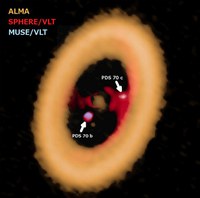Circumplanetary Disk Detection
 The combination of high-resolution ALMA dust imaging and Very Large Telescope (VLT) imaging of the ionized gas in a protoplanetary system, PDS 70, has shown evidence for accretion onto planets themselves, for the first time. PDS 70 is a planetary system forming around a 0.8 M⊙T Tauri star at a distance of 113 pc.
The combination of high-resolution ALMA dust imaging and Very Large Telescope (VLT) imaging of the ionized gas in a protoplanetary system, PDS 70, has shown evidence for accretion onto planets themselves, for the first time. PDS 70 is a planetary system forming around a 0.8 M⊙T Tauri star at a distance of 113 pc.
In this work, Isella et al. describe the discovery of a spatially unresolved source of submillimeter continuum emission (λ = 855 μm) associated with a young planet, PDS 70c, recently detected in Hα emission around the 5 Myr old T Tauri star, PDS 70. The authors interpret the emission as originating from a dusty circumplanetary disk with a dust mass between 2 x 10-3 M⊕ and 4.2 x 10-3 M⊕. Assuming a standard gas-to-dust ratio of 100, the ratio between the total mass of the circumplanetary disk and the mass of the central planet would be between 10−4 and 10−5. The authors also report the discovery of another compact continuum source 0.074 ± 0.013 arcsec southwest of a second known planet in this system, PDS 70b, that was previously detected in near-infrared images. The authors speculate that the latter source might trace dust orbiting in proximity of the planet, but more sensitive observations are required to unveil its nature.
VLT imaging of Ha emission has revealed two forming planets, present in a gap in the dust disk, at distances of 23 and 35 AU from the star, with masses of 4 and 12 MJ. ALMA 350 GHz images down to 0.05 arcsecond resolution show dust emission from the planets themselves, indicating circum-planetary disks associated with the forming planets. These mini-dust disks will eventually coalesce to form moons and dust rings, similar to those seen around the giant planets in the Solar System.
Image: ALMA 350 GHz and VLT images of the protoplanetary disk, PDS 70 (Isella et al.)
Publication: Andrea Isella (Rice University) et al., Continuum Submillimeter Emission Associated with Candidate Protoplanets, Astrophysical Journal Letters, 879, L25 (10 July 2019).
NRAO Press Release: 'Moon-forming' Circumplanetary Disk Discovered in Distant Star System




Connect with NRAO